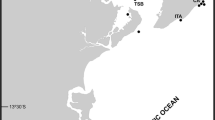Abstract
The present study considers 88 bryozoan species occurring in freshwater: 69 phylactolaemate and 19 gymnolaemate species. Roughly 49% of these species are confined to one zoogeographical region. The cosmopolitan status of species like Fredericella sultana, Plumatella repens or P. emarginata has to be reconsidered. Among the Phylactolaemata, which are phylogenetically older than the Gymnolaemata, the gelatinous species (Lophopodidae, Pectinatellidae, Cristatellidae) are more primitive than the branching tubular species (Plumatellidae, Fredericellidae).




Similar content being viewed by others
References
Backus, B. T. & W. C. Banta, 2002. NOR-chromosome morphology and evidence for rDNA selection in phylactolaemates. Hydrobiologia 482: 89–95.
Brien, P., 1960. Classe des Bryozoaires. In Grassé, P. (ed.), Traité de Zoologie, 5(2), Paris, Masson: 1054–1335.
Bushnell, J. H., 1973. The freshwater Ectoprocta: a zoogeographical discussion. In Larwood G.P. (ed.), Living and Fossil Bryozoa. Academic Press, London & New York: 503–521.
Geimer, G. & J. A. Massard, 1986. Les Bryozoaires du Grand-Duché de Luxembourg et des régions limitrophes. Travaux Scientifiques du Musée d’Histoire Naturelle de Luxembourg, 7: 1–187.
Lacourt, A. W., 1968. A monograph of the freshwater Bryozoa: Phylactolaemata. Zoölogische Verhandelingen 93: 1–159.
Mukai, H., 1999. Comparative morphological studies on the statoblasts of lower phylactolaemate bryozoans, with discussion on the systematics of Phylactolaemata. Science Reports of the Faculty of Education Gunma University 46: 51–91.
Mundy, S. P., 1980. Stereoscan studies of phylactolaemate bryozoan statoblasts including a key to the statoblasts of the British and European Phylactolaemata. Journal of Zoology 192: 511–530.
Prenant, M. & G. Bobin, 1956. Bryozoaires. Première partie. Entoproctes, Phylactolèmes, Cténostomes. Faune de France, 60: 1–398.
Rogick, M. D., 1941. Studies on freshwater Bryozoa. X. The occurrence of Plumatella casmiana in North America. Transactions of the American Microscopical Society, 60: 211–220.
Ryland, J., 2005. Bryozoa: an introductory overview. Denisia 16: 9–20.
Todd, J. A., 2000. The central role of Ctenostomes in bryozoan phylogeny. In Herrera Cubilla, A. & J. B. C. Jackson (eds), Proceedings of the 11th International Bryozoology Association Conference. Balboa (Panama), Smithsonian Tropical Research Institute: 104–135.
Toriumi, M., 1956. Taxonomical study on fresh-water Bryozoa. XVII. General consideration: Interspecific relation of described species and phylogenic consideration. Science Reports of Tohoku University Series IV (Biology) 22: 57–88.
Vinogradov, A. V., 2004. Taxonomical structure of Bryozoans Phylactolaemata. Vestnik Zoologii 38(6): 3–14.
Walzl, M. G. & E. Wöss, 2005. The soft body parts of freshwater bryozoans depicted by scanning electron microscopy. Denisia 16: 49–58.
Wiebach, F., 1960. Bryozoa. In Brohmer, P. et al. (eds), Die Tierwelt Mitteleuropas, 1(8): 1–56, pl. 1–19.
Wiebach, F., 1975. Specific structures of sessoblasts (Bryozoa, Phylactolaemata). In Pouyet, S. (ed.), Bryozoa 1974. Documents des Laboratoires de Géologie de la Faculté des Sciences de Lyon H.S. 3(1): 149–154, pl. 1–3.
Wiebach, F. & J. L. d’Hondt, 1978. Bryozoa. In Illies, J. (ed.), Limnofauna Europaea, 2. Aufl. G. Fischer, Swets & Zeitlinger, Stuttgart, New York, Amsterdam: 492–493.
Wood, T. S., 2002. Freshwater bryozoans: a zoogeographical reassessment. In Wyse Jackson P. N., C. J. Buttler & M. E. Spencer Jones (eds), Bryozoan Studies 2001. Swets & Zeitlinger, Lisse: 339–345.
Wood, T. S. & M. Lore, 2005. The higher phylogeny of Phylactolaemate bryozoans inferred from 18S ribosomal DNA seqences. In Moyano, H. I., J. M. Cancino & P. N. Wyse Jackson (eds), Bryozoan Studies 2004. A.A. Balkema Publishers, Leiden, London: 361–367.
Wood, T. S. & B. Okamura, 2005. A new key to the freshwater bryozoans of Britain, Ireland and Continental Europe, with notes on their ecology. Freshwater biological Association Scientific Publication 63: 1–113.
Author information
Authors and Affiliations
Corresponding author
Additional information
Guest editors: E. V. Balian, C. Lévêque, H. Segers & K. Martens
Freshwater Animal Diversity Assessment
Rights and permissions
About this article
Cite this article
Massard, J.A., Geimer, G. Global diversity of bryozoans (Bryozoa or Ectoprocta) in freshwater. Hydrobiologia 595, 93–99 (2008). https://doi.org/10.1007/s10750-007-9007-3
Published:
Issue Date:
DOI: https://doi.org/10.1007/s10750-007-9007-3




